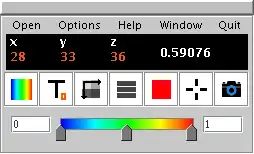 Mango main panel | |
| Developer(s) | University of Texas Health Science Center at San Antonio Jack L. Lancaster Michael J. Martinez |
|---|---|
| Stable release | 4.1
|
| Written in | Java |
| Operating system | Linux, Mac OS, Windows |
| Type | Neuroimaging software |
| License | Freeware |
| Website | ric |
Mango (Multi-Image Analysis GUI) is a non-commercial software for viewing, editing and analyzing volumetric medical images. Mango is written in Java, and distributed freely in precompiled versions for Linux, Mac OS and Microsoft Windows. It supports NIfTI, ANALYZE, NEMA and DICOM formats and is able to load and save 2D, 3D and 4D images.
Mango provides tools for creation and editing of regions of interest (ROI) within the images, surface rendering, image stacking (overlaying), filtering in space domain and histogram analysis, among other functions that can be used in neuroimaging analysis[1][2] for scientific (non-clinical) purposes.
The software can be extended with user-defined functions (plug-ins), which can be created using the Java language and the Mango API.
See also
References
- ↑ Szabó CA, Narayana S, Franklin C, et al. (Nov 2008). ""Resting" CBF in the epileptic baboon: Correlation with ketamine dose and interictal epileptic discharges". Epilepsy Res. 82 (1): 59–65. doi:10.1016/j.eplepsyres.2008.07.015. PMC 3184423. PMID 18801644.
- ↑ Narayana S, Jacks A, Robin DA, et al. (Nov 2008). "A Non-Invasive Imaging Approach to Understanding Speech Changes following Deep Brain Stimulation in Parkinson's Disease". Am J Speech Lang Pathol. 18 (2): 146–61. doi:10.1044/1058-0360(2008/08-0004). PMC 2779712. PMID 19029533.
External links
.JPG.webp)